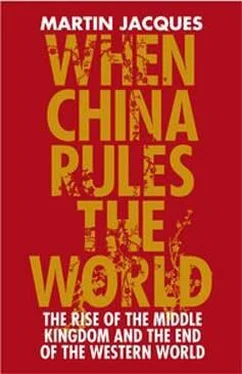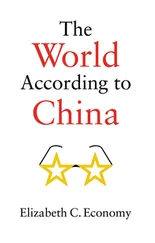The rise of China is best seen not from the vantage point of the United States or Europe, or for that matter Africa or Latin America, but East Asia. It is in China ’s own backyard that the reverberations of its rise are already being felt most dramatically and in the most far-reaching ways. If we want to understand China ’s rise, and what it might mean for the world, then this should be our starting point. The way in which China handles its rise and exercises its growing power in the East Asian region will be a very important indicator of how it is likely to behave as a global power. [855] [855] Zhang Yunling and Tang Shiping, ‘ China ’s Regional Strategy’, in David Shambaugh, ed., Power Shift: China and Asia’s New Dynamics (Berkeley: University of California Press, 2005), pp. 51-2.
It is difficult to achieve the status of a global power without first becoming the dominant power in one’s own region. Britain is unusual in this respect: it acquired global hegemony in the nineteenth century even though it didn’t succeed in achieving a decisive pre-eminence in Europe. In contrast, the United States, confronted with no serious rivals, achieved overwhelming dominance in the Americas prior to becoming a global superpower in the second half of the twentieth century. China faces a far more formidable task in seeking to become the premier power in East Asia. The region accounts for one-third of the world’s population and China has to contend with two rivals, namely Japan and the United States, which stand in the way of its ambitions. Japan is the most advanced as well as largest (as measured by GDP according to exchange rates) economy in the region, while the United States, by virtue of its military alliances, bases and especially naval presence, remains the most powerful military force in East Asia. Furthermore, China shares borders with Russia to its north and India to its south-west, both of which are powerful players. China ’s path to regional pre-eminence will be paved with difficulty and is bound to be a complicated process.
History, however, offers some succour for China ’s ambitions. Until the latter decades of the nineteenth century, China enjoyed overwhelming regional dominance: it was to the Middle Kingdom that all others, in varying degrees — depending on their distance from Beijing — paid homage, acknowledging their status as the Celestial Kingdom ’s inferior. It was a hierarchical system of relations whose tentacles stretched across much of East Asia, with China at its centre. In the tributary system, as it was known, non-Chinese rulers observed the appropriate forms and ceremonies in their contact with the Chinese emperor. Taken together, those practices constituted the tribute system. During the Qing period they included receiving a noble rank in the Qing hierarchy, dating their communications by the Qing calendar, presenting tribute memorials on statutory occasions together with a symbolic gift of local products, performing the kow-tow at the Qing court, receiving imperial gifts in return and being granted certain trading privileges and protection. [856] [856] John King Fairbank, ed., The Chinese World Order: Traditional China’s Foreign Relations (Cambridge, Mass.: Harvard University Press, 1968), pp. 10–11; Alexander Vuving, ‘Traditional and Modern Sino-Vietnamese Relations’, in Anthony Reid and Zheng Yangwen, eds, Negotiating Asymmetry: China’s Place in Asia (Singapore: NUS Press, 2009), p. 2.
If a ruler recognized the superiority of Chinese civilization and paid tribute to the emperor, then the emperor generally pursued a policy of non-interference, leaving domestic matters to the local ruler. It was thus an essentially cultural and moral rather than administrative or economic system. The emperor exercised few coercive powers but maintained control for the most part symbolically. The fact that Chinese hegemony was exercised in such a light and relatively superficial way enabled it to be maintained over a huge and very diverse population for long periods of time. The tributary system was far from universal, but Korea, part of Japan, Vietnam and Myanmar all paid tributes to China, while a large number of South-East Asian states, including Malacca and Thailand, either paid tribute or acknowledged Chinese suzerainty. Those countries that were closer to China in terms of geography and culture were considered to be more equal than those that were not. So, for example, China was considered the big brother, Korea a middle brother and Japan a younger brother.
Given the extent of the system, the diversity of the countries and cultures embraced, and the vast time-period involved, it would be wrong to conceive of the tributary system as uniform or monolithic. Varying from country to country and from dynasty to dynasty, [857] [857] Seo-Hyun Park, ‘ Small States and the Search for Sovereignty in Sinocentric Asia: The Case of Japan and Korea in the Late Nineteenth Century’, in Reid and Zheng, Negotiating Asymmetry , pp. 3- 10.
the Chinese world order might appropriately be described, in the Chinese historian William A. Callahan’s words, as ‘one civilization, many systems’. [858] [858] William A. Callahan, Contingent States (Minneapolis: University of Minnesota Press, 2004), pp. 88- 9.
Although they shared things in common, the tributary system worked very differently, for example, for Japan and Korea, with Japan enjoying much greater autonomy from China than Korea, and from time to time even rebelling against the tributary system. No doubt this partly explains why later Japan was able to display such remarkable independence of action in the aftermath of the Meiji Restoration, with its rejection of the Sinocentric world and its turn to the West. [859] [859] Park, ‘ Small States, and the Search for Sovereighty in Sinocentity Asia’, pp. 3- 11.
Perhaps it also helps to explain South Korea ’s recent turn towards China. Notwithstanding these variations, however, the common thread running through the tributary system was an acceptance of China ’s cultural superiority. This was the reason why the acceding states voluntarily acquiesced in an arrangement which they regarded to be in their interests as well as the Middle Kingdom’s. [860] [860] Chung-in Moon and Seung-won Suh, ‘Overcoming History: The Politics of Identity and Nationalism’, Global Asia , 2: 1, (5 April 2007), pp. 35-6.
The relative stability of the tributary system over such a long historical period was partly a function of its flexibility but, above all, because China was overwhelmingly dominant within it: inequality, in other words, served to promote order. [861] [861] David C. Kang, ‘Getting Asia Wrong: The Need for New Analytical Frameworks’, International Security , 27: 4 (Spring 2003), pp. 66- 7.
From the second half of the nineteenth century, with the growing power of the European nations and the decline of China, the European-conceived Westphalian system, together with its colonial subsystem, steadily replaced the tributary system as the organizing principle of interstate relations in the region, or, more accurately, perhaps, was superimposed upon the existing system. [862] [862] Ibid., p. 11; Callahan, Contingent States , p. 89.
Given that it constituted the regional system in East Asia for more than 2,500 years, the tributary system remains deeply embedded in the historical memory of the region. Most countries in East Asia had some experience of it, often as recently as a century ago, and certainly not more than a century and a half ago. Even as it began to break down towards the end of the century, elements of the tributary system continued to survive until well into the twentieth century. While it seems inconceivable that any future Chinese hegemony in East Asia could take the form of the old tributary system, it is certainly reasonable to entertain the idea that it could bear at least some of its traces. There is still an overwhelming assumption on the part of the Chinese that their natural position lies at the epicentre of East Asia, that their civilization has no equals in the region, and that their rightful position, as bestowed by history, will at some point be restored in the future. China still frequently refers to its Asian neighbours as ‘periphery countries’, suggesting that old ways of thinking have not changed as much as one might expect. [863] [863] Suisheng Zhao, ed., Chinese Foreign Policy (New York: M. E. Sharpe, 2004), p. 256.
Former habits and attitudes have a strange way of reasserting themselves in new contexts. It would not be entirely surprising, therefore, if elements of the old tribute system were to find renewed expression as China once again emerges as the dominant centre of the East Asian economy. [864] [864] Wang Gungwu, ‘ China and Southeast Asia’, in Shambaugh, Power Shift , p. 197; Kang, ‘Getting Asia Wrong’, p. 84.
Читать дальше












